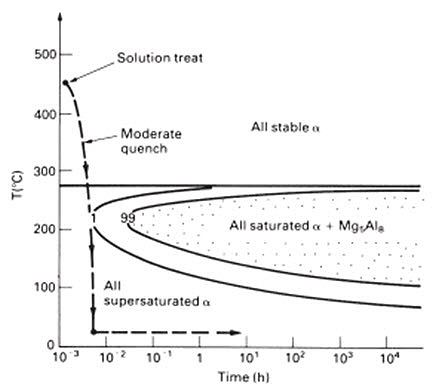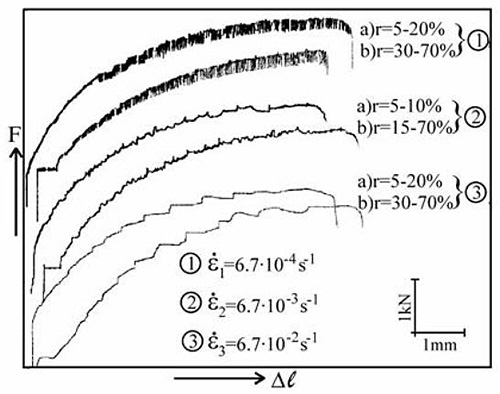AlMg Alloys: Part Two
Abstract
In recent times there has been an ever increasing need for lightweight materials with increased strength to help meet tighter deadlines relating to cost savings.
Al-Mg alloys can offer excellent solutions for these requirements by exhibiting favorable formability, high strength and high strain hardening ability offering not only strong finished product but stable.
It is well established that Al-Mg alloys achieve a combination of good mechanical properties and formability through solid solution strengthening, and Al-Mg alloys have thus found commercial use in cast and wrought forms for a variety of applications. However, the recent consistent demand for a reduction in the weight of structural components, coupled with an increase in strength, has focused attention on the development of new structural aluminum alloys of high specific strength. There is apparently great potential for an age-hardening response in Al-Mg alloys according to the equilibrium phase diagram.
The phase diagram (see Figure 1) tells us that below 275°C, the 5.5% alloy has an equilibrium structure that is two-phase, α+Mg5Al8. If we then cool the alloy slowly below 275°C, Al and Mg atoms will diffuse together to form precipitates of the intermetallic compound Mg5Al8. However, below 275°C, diffusion is slow and the C-curve for the precipitation reaction is well over to the right (Figure 2). So, if cooling of the 5.5% alloy occurs moderately quickly there is potential to miss the nose of the C-curve. None of the Mg will be taken out of solution as Mg5Al8, and what would be left would be a supersaturated solid solution at room temperature. Solution hardening is not confined to 5000 series aluminum alloys.
The other alloy series all have elements dissolved in solid solution; and they are all solution strengthened to some degree. But most aluminum alloys owe their strength to fine precipitates of intermetallic compounds, and solution strengthening is not dominant as it is in the 5000 series. Turning to the other light alloys, the most widely used titanium alloy (Ti-6Al4V) is dominated by solution hardening (Ti effectively dissolves about 7wt% Al, and has complete solubility for V. Finally, magnesium alloys can be solution strengthened with Li, Al, Ag and Zn, which dissolve in Mg by between 2 and 5wt%.

Figure 1: Semi-schematic TTT diagram for the precipitation of Mg5Al8 from the Al-5.5 wt%Mg solid solution
The Al-Mg alloys have a favorable formability, as due to solution hardening they can achieve high strength and high strain hardening ability, which enable a stable behavior in the complex forming operation, reducing the further material flow in the locally strained regions. Such behavior is improved in alloys with higher Mg content. Besides the favorable forming behavior, the present solute atoms can induce some harmful surface appearance of produced auto body parts.
In Al-Mg alloys the dislocation reactions with solute Mg atoms, i.e. the dynamic strain aging (DSA), is the main source of unstable plastic flow during the uniaxial tension test. This unstable flow in alloys with more than 2% magnesium appeared as a yield point elongation, known as a Lüders elongation. This inhomogeneous deformation occurs within the first few percent of straining when the stress is constant.
After that – at higher strains, the DSA is manifested as a discontinuous or serrated yielding. Flow curves for a highly alloyed AlMg6.5Mn alloy sheet, after different treatment and strain rates are shown in Figure 2. The Lüders elongation plateaus and serrations or discontinuous yielding ranges are very clear. Both Lüdering and serrated yielding during uniaxial stretching cause the appearance of specific surface relief known as "A" ("flamboyant") and "B" ("parallel bands") type surface markings, respectively.

Figure 2: Load extension curves for the AlMg6.5Mn sheets at different strain rates and working conditions
The Al-Mg type alloy sheets are cost-effective and a very promising material group for automotive application. The most important obstacles for their wider applications are related to the bed surface appearance developing during the forming operations and to the softening effect coming into play in the paint baking sequence of car bodies. The harmful surface appearance is closely related to dynamic strain aging (DSA) due the reactions of Mg atoms with mobile dislocations. So, the solution for suppressing the DSA is firstly defined as a particular temperature – strain rate conditions necessary for performing the forming operation when the serrated yielding vanishes.
For avoiding the harmful "A" type stretcher strain markings (developing during the yield point elongation), a coarse grain size was found to be beneficial. This effect is limited, as the coarse grains can cause other problems in the forming operations. The specific – low reduction treatment of the annealed sheet material (characterized with higher density of mobile dislocations) seems to be promising in suppressing the yield point elongation. Finally, it was also noticed that the surface banding is stress state dependent and that it can disappear in equibiaxial stretching.
The softening effect as a natural consequence of the recovery process in the deformed parts during paint baking was prevented introducing a small amount of copper, which can produce an additional hardening effect compensating the mentioned recovery induced softening.
Read more
Access Precise Properties of Aluminum Alloys Now!
Total Materia Horizon contains property information for 30,000+ alumiums: composition, mechanical, physical and electrical properties, nonlinear properties and much more.

Get a FREE test account at Total Materia Horizon and join a community of over 500,000 users from more than 120 countries.